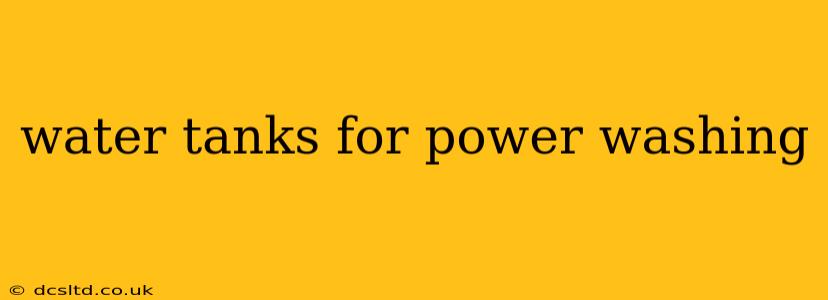Power washing is a demanding task, requiring a consistent and ample supply of water. A dedicated water tank can significantly enhance your power washing efficiency, especially for jobs far from a water source or when dealing with larger projects. This guide explores the key considerations when choosing a water tank for your power washing needs, helping you select the perfect fit for your projects.
What Size Water Tank Do I Need for Power Washing?
The ideal water tank size depends heavily on the size and scope of your power washing projects. Smaller tanks (e.g., 50-gallon) are suitable for smaller residential jobs or spot cleaning. Larger projects, such as cleaning commercial buildings or expansive driveways, will require significantly larger tanks (e.g., 100-gallon or even larger). Consider the duration of your typical jobs and the water consumption rate of your pressure washer to determine your necessary tank capacity. Overestimating is always better than running out of water mid-job.
What are the Different Types of Water Tanks for Power Washing?
Several types of water tanks are suitable for power washing, each offering unique advantages and disadvantages:
-
Plastic Water Tanks: These are generally the most affordable option, lightweight, and relatively easy to transport. However, they might not be as durable as other options and are susceptible to damage from punctures or extreme temperatures.
-
Metal Water Tanks (Steel or Stainless Steel): Metal tanks are more robust and durable, offering better resistance to damage and extreme conditions. Stainless steel tanks are particularly resistant to corrosion and are ideal for long-term use. However, they are typically heavier and more expensive than plastic alternatives.
-
Collapsible Water Tanks: These are highly portable and convenient for jobs requiring frequent relocation. They are lightweight when empty and can be easily stored. However, they might have a lower water capacity compared to rigid tanks.
-
Built-in Water Tanks (on some Pressure Washers): Some pressure washers come with built-in water tanks, eliminating the need for a separate tank. This is convenient but limits your water capacity to the built-in tank's size.
How Much Water Does a Power Washer Use?
Power washer water consumption depends on several factors, including the pressure washer's GPM (gallons per minute) rating, the duration of use, and the size of the cleaning area. A typical residential pressure washer might use between 1.5 and 3 gallons per minute. Larger commercial units can use significantly more. Calculate your water needs by multiplying the GPM by the estimated cleaning time in minutes.
Are There Any Special Considerations for Water Tank Placement?
Yes, proper placement of your water tank is crucial for efficient power washing. Ensure the tank is placed on a level surface to prevent leaks or instability. Consider the tank's proximity to your power washer, minimizing the length of the water supply hose to reduce pressure loss. Avoid placing the tank in direct sunlight to prevent excessive water temperature increase, which could affect the pressure washer's performance.
What are the Best Brands of Water Tanks for Power Washing?
Several reputable brands manufacture water tanks suitable for power washing. Research reviews and compare features before making a purchase. Focus on durability, capacity, and ease of use when selecting a brand. (Note: I cannot endorse specific brands due to the constantly shifting landscape of products and reviews.)
How Do I Maintain My Water Tank for Power Washing?
Proper maintenance extends the lifespan of your water tank. After each use, drain the tank completely to prevent algae or bacteria growth. Clean the tank regularly to remove any sediment or debris. Inspect the tank for any signs of damage or leaks and address them promptly. For metal tanks, consider applying a protective coating to prevent corrosion.
By considering these factors, you can choose the most suitable water tank for your power washing needs, significantly improving your efficiency and effectiveness. Remember to always prioritize safety and follow the manufacturer's instructions when using your pressure washer and water tank.
